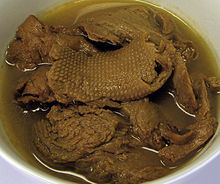Seitan

Seitan or seitan (also Mianjin , wheat gluten ) is a food made from wheat protein ( gluten ) with a meat-like consistency.
It is still part of traditional Japanese tempura cuisine today. Seitan was also the product name of a Japanese wheat gluten product that was developed in 1962 by the macrobiotic teacher George Ohsawa with Kiyoshi Mokutani, the head of the Marushima Shoyu Company . In 1969, Seitan was first exported to the USA by the Erewhon company.
Manufacture and use
To make seitan, wheat flour is first kneaded with water to form a dough and, after a resting time, washed out repeatedly by kneading under water, which gradually removes a large part of the starch from the dough and leaves a tough, gluten-rich mass. As an alternative to wheat flour, gluten flour can also be used, in which the starch and gluten have already been separated so that washing out is not necessary. Seitan gets its meat-like consistency and taste by boiling or steaming the raw mixture in a marinade that traditionally consists of soy sauce , seaweed and spices . It is then cut into slices or pieces and can then be marinated or used directly, for example fried, deep-fried or baked in the oven. Seitan can be used as a substitute for meat in many meat dishes, pickled and also frozen.
A Japanese variation of seitan is Fu (麩 "Fu", literally " gluten "). Fu is first made like seitan, but then roasted, steamed and then dried. That's why it's less dense than seitan. Before preparation, it is soaked in hot water, then squeezed out and can then be used like seitan. Like a sponge, it absorbs a lot of liquid during preparation and thus increases its volume.
In the West, vegetarian-vegan meat substitutes in particular are made industrially from seitan - for example vegetarian “ sausages ”, “ minced meat ”, “ gyros ” or “ schnitzel ”.
Nutritional value
100 grams of seitan usually contain 4, rarely up to 40 grams, carbohydrates , 25 grams of protein and 1 gram of fat .
The protein composition of seitan only provides the essential amino acid lysine in small quantities, which is why the biological value is relatively low and other foods containing lysine should also be included in the diet.
Word origin
The name セ イ タ ン Seitan is a neologism coined by the Japanese inventor of the macrobiotic diet , Georges Ohsawa (Nyoichi Sakurazawa); through him the court became known in the West as well.
Individual evidence
- ↑ Aveline Kushi: Aveline Kushi's great book of macrobiotic cuisine. Ost-West Verlag, Völklingen 1987. Page 121. ISBN 3930564076
- ^ History of Erewhon - Natural Foods Pioneer in the United States (1966-2011), p. 22
- ↑ Aveline Kushi: Aveline Kushi's great book of macrobiotic cuisine. Ost-West Verlag, Völklingen 1987. Page 128. ISBN 3930564076
- ↑ http://www.lebensmittel-tabelle.de/highprot-lowcal.html
- ↑ Peter R Shewry: Wheat (Review) . In: Journal of Experimental Botany . 60, No. 6, 2009, pp. 1537-1553. doi : 10.1093 / jxb / erp058 . PMID 19386614 .
- ^ Food and Agriculture Organization of the United Nations: Dietary protein quality evaluation in human nutrition. Report of an FAO Expert Consultation . 2013.
Web links
- Production and recipes ( Memento from January 26, 2015 in the Internet Archive )
- Make seitan yourself
- Seitan recipes


